Latitudinal Characteristics of Nighttime Electron Temperature in the Topside Ionosphere and Its Dependence on Solar and Geomagnetic Activities
Abstract
:1. Introduction
2. Datasets, Statistical Methods, and Models
2.1. Datasets
2.2. Methods
2.3. Models
3. Results
3.1. Magnetic Latitudinal Characteristics of Electron Temperature
3.2. Movement of Temperature Characteristic Positions
3.3. Variations in the Electron Temperature and Density Value
4. Discussion
5. Conclusions
Author Contributions
Funding
Data Availability Statement
Acknowledgments
Conflicts of Interest
Appendix A
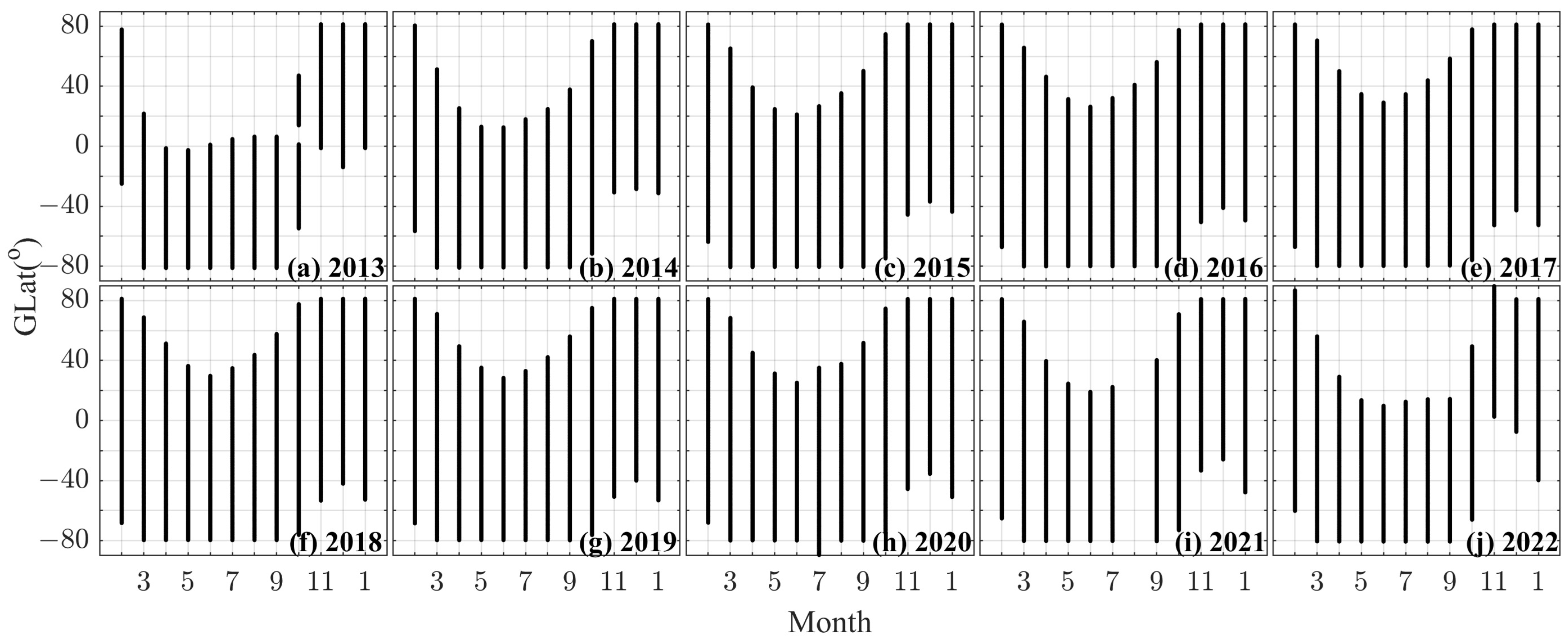
Appendix B
| Year | Equator | Sub-Auroral Latitude | Auroral Latitude | |||||||
|---|---|---|---|---|---|---|---|---|---|---|
| NH | SH | NH | SH | |||||||
| Quiet | Disturbance | Quiet | Disturbance | Quiet | Disturbance | Quiet | Disturbance | Quiet | Disturbance | |
| 2013 | 2.23 × 10−22 | 2.57 × 10−24 | 0 | 6.89 × 10−94 | 5.5 × 10−307 | 4.3 × 10−228 | 1.08 × 10−90 | 1.87 × 10−36 | 5.0 × 10−139 | 2.77 × 10−64 |
| 2014 | 5.28 × 10−30 | 0.00100 | 1.1 × 10−238 | 3.5e × 10−287 | 0 | 6.5 × 10−171 | 5.4 × 10−111 | 0 | 3.8 × 10−118 | 4.66 × 10−74 |
| 2015 | 5.0 × 10−106 | 4.2 × 10−231 | 1.9 × 10−202 | 0 | 0 | 5.2 × 10−163 | 8.41 × 10−12 | 3.1 × 10−177 | 1.1 × 10−238 | 3.44 × 10−58 |
| 2016 | 1.99 × 10−31 | 4.15 × 10−59 | 0 | 2.4 × 10−302 | 0 | 0 | 3.10 × 10−17 | 5.39 × 10−7 | 0 | 3.0 × 10−248 |
| 2017 | 8.17 × 10−69 | 2.26 × 10−26 | 0 | 0 | 0 | 0 | 1.03 × 10−28 | 1.45 × 10−7 | Nan | Nan |
| 2018 | 9.3 × 10−161 | 1.15 × 10−62 | 0 | 0 | 0 | 0 | 4.9 × 10−143 | 1.11 × 10−43 | Nan | Nan |
| 2019 | 5.50 × 10−44 | 2.91 × 10−27 | 0 | 6.0 × 10−257 | 0 | 0 | 8.1 × 10−150 | 5.16 × 10−7 | Nan | Nan |
| 2020 | 7.2 × 10−296 | 1.0 × 10−105 | 0 | 0 | 0 | 7.2 × 10−213 | 1.47 × 10−88 | 5.19 × 10−40 | Nan | Nan |
| 2021 | 0 | 7.4 × 10−134 | 0 | 0 | 0 | 0 | 5.46 × 10−26 | 0.00119 | Nan | Nan |
| 2022 | 0.000165 | 1.45 × 10−9 | 0 | 0 | 1.1 × 10−179 | 0 | 2.59 × 10−16 | 1.74 × 10−21 | 0 | 2.6 × 10−188 |
References
- Schunk, R.W.; Nagy, A.F. Ionospheres: Physics, Plasma Physics, and Chemistry, 2nd ed.; Cambridge Atmospheric and Space Science Series; Cambridge University Press: Cambridge, UK, 2009. [Google Scholar]
- Horwitz, J.L.; Brace, L.H.; Comfort, R.H.; Chappell, C.R. Dual-spacecraft measurements of plasmasphere-ionosphere coupling. J. Geophys. Res. 1986, 91, 11203–11216. [Google Scholar] [CrossRef]
- Su, Y.Z.; Oyama, K.I.; Bailey, G.J.; Takahashi, T.; Watanabe, S. Spatial and temporal variations of the electron temperature at equatorial anomaly latitudes. Adv. Space Res. 1996, 18, 83–86. [Google Scholar] [CrossRef]
- Kakinami, Y.; Balan, N.; Liu, J.Y.; Oyama, K.I. Predawn ionospheric heating observed by Hinotori satellite. J. Geophys. Res. Space Phys. 2010, 115, A01304. [Google Scholar] [CrossRef]
- Chao, C.K.; Su, S.Y.; Yeh, H.C. Presunrise ion temperature enhancement observed at 600 km low- and mid-latitude ionosphere. Geophys. Res. Lett. 2003, 30, 1187. [Google Scholar] [CrossRef]
- Chao, C.K.; Su, S.Y.; Huba, J.D.; Oyama, K.I. Modeling the presunrise plasma heating in the low-to midlatitude topside ionospheres. J. Geophys. Res. 2010, 115, A09304. [Google Scholar] [CrossRef]
- Wang, W.; Burns, A.G.; Killeen, T.L. A numerical study of the response of ionospheric electron temperature to geomagnetic activity. J. Geophys. Res. 2006, 111, A11301. [Google Scholar] [CrossRef]
- Kil, H.; Paxton, L.J.; Schaefer, R.K. Simultaneous detection of signatures of conjugate photoelectrons in the ionosphere and thermosphere. J. Geophys. Res. Space Phys. 2022, 127, e2021JA030121. [Google Scholar] [CrossRef] [PubMed]
- Ren, Z.; Wan, W.; Liu, L.; Zhao, B.; Wei, Y.; Yue, X.; Heelis, R.A. Longitudinal variations of electron temperature and total ion density in the sunset equatorial topside ionosphere. Geophys. Res. Lett. 2008, 35, L05108. [Google Scholar] [CrossRef]
- Oyama, K.-I.; Balan, N.; Watanabe, S.; Takahashi, T.; Isoda, F.; Bailey, G.J.; Oya, H. Morning overshoot of Te enhanced by downward plasma drift in the equatorial topside ionosphere. J. Geomagn. Geoelectr. 1996, 48, 959–966. [Google Scholar] [CrossRef]
- Otsuka, Y.; Kawamarura, S.; Balan, N.; Fukao, S.; Bailey, G.J. Plasma temperature variations in the ionosphere over the middle and upper atmosphere radar. J. Geophys. Res. Space Phys. 1998, 103, 20705–20713. [Google Scholar] [CrossRef]
- Stolle, C.; Liu, H.; Truhlík, V.; Lühr, H.; Richards, P.G. Solar flux variation of the electron temperature morning overshoot in the equatorial F region. J. Geophys. Res. 2011, 116, A04308. [Google Scholar]
- Alexander, L.T. Diurnal variation of electron and ion temperatures with altitude. Int. J. Appl. Sci. Technol. 2014, 4, 163–168. [Google Scholar]
- Yang, T.-Y.; Park, J.; Kwak, Y.-S.; Oyama, K.-I.; Minow, J.I.; Lee, J.-J. Morning overshoot of electron temperature as observed by the Swarm constellation and the International Space Station. J. Geophys. Res. Space Phys. 2020, 125, e2019JA027299. [Google Scholar] [CrossRef]
- Hanson, W.B.; Naggy, A.F.; Moffett, R.J. Ogo-6 measurements of super cooled plasma in the equatorial exosphere. J. Geophys. Res. 1973, 78, 751–756. [Google Scholar] [CrossRef]
- Oyama, K.; Abdu, M.A.; Balan, N.; Bailey, G.J.; Watanabe, S.; Takahashi, T.; de Paula, E.R.; Batista, I.S.; Isoda, F.; Oya, H. High electron temperature associated with the prereversal enhancement in the equatorial ionosphere. J. Geophys. Res. 1997, 102, 417–424. [Google Scholar] [CrossRef]
- Pavlov, A.V.; Fukao, S.; Karwamura, S. Comparison of the measured and modelled electron densities, and electron and ion temperatures in the low-latitude ionosphere during 12–21 March 1988. Ann. Geophys. 2004, 22, 2747–2763. [Google Scholar] [CrossRef]
- Ryu, K.; Kwak, Y.; Kim, Y.H.; Park, J.; Lee, J.; Min, K. Variation of the topside ionosphere during the last solar minimum period studied with multi satellite measurements of electron density and temperature. J. Geophys. Res. Space Phys. 2016, 121, 7269–7286. [Google Scholar] [CrossRef]
- Balan, N.; Oyama, K.I.; Bailey, G.J.; Fukao, S.; Watanabe, S.; Abdu, M.A. A plasma temperature anomaly in the equatorial topside ionosphere. J. Geophys. Res. 1997, 102, 7485–7492. [Google Scholar] [CrossRef]
- Liang, J.; Xu, J.; Zhang, Q.; Liu, J.; Zhang, Y.; Zhang, S.; Wang, X.; Xing, Z.; Wu, K. Global distribution of electron temperature enhancement at mid-low latitudes observed by DMSP F16 satellite. J. Geophys. Res. Space Phys. 2023, 128, e2023JA031513. [Google Scholar] [CrossRef]
- Kil, H.; Schaefer, R.K.; Paxton, L.J.; Jee, G. The far ultraviolet signatures of conjugate photoelectrons seen by the Special Sensor Ultraviolet Spectrographic Imager. Geophys. Res. Lett. 2020, 47, e2019GL086383. [Google Scholar] [CrossRef]
- Fok, M.-C.; Kozyra, J.U.; Brace, L.H. Solar cycle variation in the subauroral electron temperature enhancement: Comparison of AE-C and DE 2 satellite observations. J. Geophys. Res. Space Phys. 1991, 96, 1861–1866. [Google Scholar] [CrossRef]
- Prolss, G.W. Subauroral electron temperature enhancement in the nighttime ionosphere. Ann. Geophys. 2006, 24, 1871–1885. [Google Scholar] [CrossRef]
- Bhuyan, P.K.; Chamua, M.; Subrahmanyam, P.; Garg, S.C. Diurnal, seasonal and latitudinal variations of electron temperature measured by the SROSS C2 satellite at 500 km altitude and comparison with the IRI. Ann. Geophys. 2002, 20, 807–815. [Google Scholar] [CrossRef]
- Chamua, M.; Bhuyan, P.K.; Subrahmanyam, P.; Garg, S.C. Diurnal, seasonal, latitudinal and solar cycle variation of electron temperature in the topside f-region of the indian zone ionosphere. Ann. Geophys. 2007, 25, 1995–2006. [Google Scholar] [CrossRef]
- Sharma, D.K.; Rai, J.; Israil, M.; Subrahmanyam, P. Diurnal, seasonal and latitudinal variations of ionospheric temperatures of the topside f region over the indian region during solar minimum (1995–1996). J. Atmos. Solar-Terr. Phys. 2005, 67, 269–274. [Google Scholar] [CrossRef]
- Watanabe, S.; Oyama, K.-I.; Abdu, M.A. Computer simulations of electron and ion densities and temperatures in the equatorial F region and comparison with Hinotori results. J. Geophys. Res. 1996, 100, 14581–14590. [Google Scholar] [CrossRef]
- Zhang, S.-R.; Holt, J.M. Ionospheric plasma temperatures during 1976–2001 over Millstone Hill. Adv. Space Res. 2004, 33, 963–969. [Google Scholar] [CrossRef]
- Lei, J.; Roble, R.G.; Wang, W.; Emery, B.A.; Zhang, S.-R. Electron temperature climatology at Millstone Hill and Arecibo. J. Geophys. Res. Space Phys. 2007, 112, A02302. [Google Scholar] [CrossRef]
- Bilitza, D.; Truhlik, V.; Richards, P.; Abe, T.; Triskova, L. Solar cycle variations of mid-latitude electron density and temperature: Satellite measurements and model calculations. Adv. Space Res. 2007, 39, 779–789. [Google Scholar] [CrossRef]
- Truhlik, V.; Bilitza, D.; Triskova, L. Latitudinal variation of the topside electron temperature at different levels of solar activity. Adv. Space Res. 2009, 44, 693–700. [Google Scholar] [CrossRef]
- Truhlik, V.; Triskova, L.; Bilitza, D.; Podolska, K. Variations of daytime and nighttime electron temperature and heat flux in the upper ionosphere, topside ionosphere and lower plasmasphere for low and high solar activity. J. Atmos. Solar-Terr. Phys. 2009, 71, 2055–2063. [Google Scholar] [CrossRef]
- Pignalberi, A.; Truhlik, V.; Giannattasio, F.; Coco, I.; Pezzopane, M. Mid- and High-Latitude Electron Temperature Dependence on Solar Activity in the Topside Ionosphere through the Swarm B Satellite Observations and the International Reference Ionosphere Model. Atmosphere 2024, 15, 490. [Google Scholar] [CrossRef]
- Delorey, D.E.; Pruneau, P.N.; Parsons, C.M. Database Development for the DMSP SSIES Experiment; Technical Report GL-TR-89-0066; Air Force Geophysics Laboratory, Hanscom Air Force Base: Bedford, MA, USA, 1989. [Google Scholar]
- Giraud, A.; Petit, M. Ionospheric Techniques and Phenomena. Geophys. Astrophys. Monogr. 1978, 13, 284. [Google Scholar]
- Bilitza, D.; Pezzopane, M.; Truhlik, V.; Altadill, D.; Reinisch, B.W.; Pignalberi, A. The International Reference Ionosphere model: A review and description of an ionospheric benchmark. Rev. Geophys. 2022, 60, e2022RG000792. [Google Scholar] [CrossRef]
- Bilitza, D. Implementation of the new electron temperature model in IRI. Adv. Space Res. 1985, 5, 117–121. [Google Scholar] [CrossRef]
- Brace, L.H.; Theis, R.F. Global empirical models of ionospheric electron temperature in the upper F-region and plasmasphere based on in situ measurements from atmosphere explorer C, ISIS 1 and ISIS 2 satellites. J. Atmos. Terr. Phys. 1981, 43, 1317–1343. [Google Scholar] [CrossRef]
- Spenner, K.; Plugge, R. Empirical model of global electron temperature distribution between 300 and 700 km based on data from AEROS-A. J. Geophys. 1979, 46, 43–56. [Google Scholar]
- Truhlik, V.; Bilitza, D.; Třísková, L. A new global empirical model of the electron temperature with inclusion of the solar activity variations for IRI. Earth Planets Space 2012, 64, 531–543. [Google Scholar] [CrossRef]
- Bilitza, D.; Xiong, C. A solar activity correction term for the IRI topside electron density model. Adv. Space Res. 2021, 68, 2124–2137. [Google Scholar] [CrossRef]
- Pignalberi, A.; Giannattasio, F.; Truhlik, V.; Coco, I.; Pezzopane, M.; Consolini, G.; De Michelis, P.; Tozzi, R. On the Electron Temperature in the Topside Ionosphere as Seen by Swarm Satellites, Incoherent Scatter Radars, and the International Reference Ionosphere Model. Remote Sens. 2021, 13, 4077. [Google Scholar] [CrossRef]
- Kutiev, I.; Marinov, P. Topside sounder model of scale height and transition height characteristics of the ionosphere. Adv. Space Res. 2007, 39, 759–766. [Google Scholar] [CrossRef]
- Chen, Y.; Liu, L.; Le, H. Solar activity variations of nighttime ionospheric peak electron density. J. Geophys. Res. 2008, 113, A11306. [Google Scholar] [CrossRef]
- Schunk, R.W.; Nagy, A.F. Electron temperatures in the F region ionosphere: Theory and observations. Rev. Geophys. Space Phys. 1978, 16, 355–399. [Google Scholar] [CrossRef]
- Watanabe, S.; Oyama, K.-I. Effects of neutral wind on the electron temperature at a height of 600 km in the low latitude region. Ann. Geophys. 1996, 14, 290–296. [Google Scholar] [CrossRef]
- Newell, P.T.; Feldstein, Y.I.; Galperin, Y.I.; Meng, C.I. Morphology of nightside precipitation. J. Geophys. Res. Space Phys. 1996, 101, 10737–10748. [Google Scholar] [CrossRef]
- Watanabe, S.; Oyama, K.I.; Abe, T. Electron temperature structure around mid-latitude ionospheric trough. Planet. Space Sci. 1989, 37, 1453–1460. [Google Scholar] [CrossRef]
- Su, F.; Wang, W.; Burns, A.G.; Yue, X.; Zhu, F. The correlation between electron temperature and density in the topside ionosphere during 2006–2009. J. Geophys. Res. Space Phys. 2015, 120, 10724–10739. [Google Scholar] [CrossRef]
- Pignalberi, A.; Giannattasio, F.; Truhlik, V.; Coco, I.; Pezzopane, M.; Alberti, T. Investigating the main features of the correlation between electron density and temperature in the topside ionosphere through Swarm satellites data. J. Geophys. Res. Space Phys. 2024, 129, e2023JA032201. [Google Scholar] [CrossRef]
- Bankov, L.; Heelis, R.; Parrot, M.; Berthelier, J.-J.; Marinov, P.; Vassileva, A. WN4 effect on longitudinal distribution of different ion species in the topside ionosphere at low latitudes by means of DEMETER, DMSP-F13 and DMSP-F15 data. Ann. Geophys. 2009, 27, 2893–2902. [Google Scholar] [CrossRef]
- Chen, C.Y.; Liu, T.J.Y.; Lee, I.T.; Rothkaehl, H.; Przepiorka, D.; Chang, L.C.; Matyjasiak, B.; Ryu, K.; Oyama, K. The midlatitude trough and the plasmapause in the nighttime ionosphere simultaneously observed by DEMETER during 2006–2009. J. Geophys. Res. Space Phys. 2018, 123, 5917–5932. [Google Scholar] [CrossRef]
- Yang, N.; Le, H.; Liu, L. Statistical analysis of ionospheric mid-latitude trough over the northern hemisphere derived from GPS total electron content data. Earth Planets Space 2015, 67, 196. [Google Scholar] [CrossRef]
- He, S.; Zhang, D.; Hao, Y.; Xiao, Z. Statistical study on the occurrence of the ionospheric mid-latitude trough and the variation of trough minimum location over northern hemisphere. Chin. J. Geophys. 2020, 63, 31–46. (In Chinese) [Google Scholar]
- Karpachev, A.T. Variations in the winter troughs’ position with local time, longitude, and solar activity in the Northern and Southern Hemispheres. J. Geophys. Res. Space Phys. 2019, 124, 8039–8055. [Google Scholar] [CrossRef]
- Horwitz, J.L.; Comfort, R.H.; Richards, P.G.; Chandler, M.O.; Chappell, C.R.; Anderson, P.; Hanson, W.B.; Brace, L.H. Plasmasphere-ionosphere coupling: 2. ion composition measurements at plasmaspheric and ionospheric altitudes and comparison with modeling results. J. Geophys. Res. Space Phys. 1990, 95, 7949–7959. [Google Scholar] [CrossRef]
- Schunk, R.W. A mathematical model of the middle and high latitude ionosphere. Pure Appl. Geophys. 1988, 127, 255–303. [Google Scholar] [CrossRef]
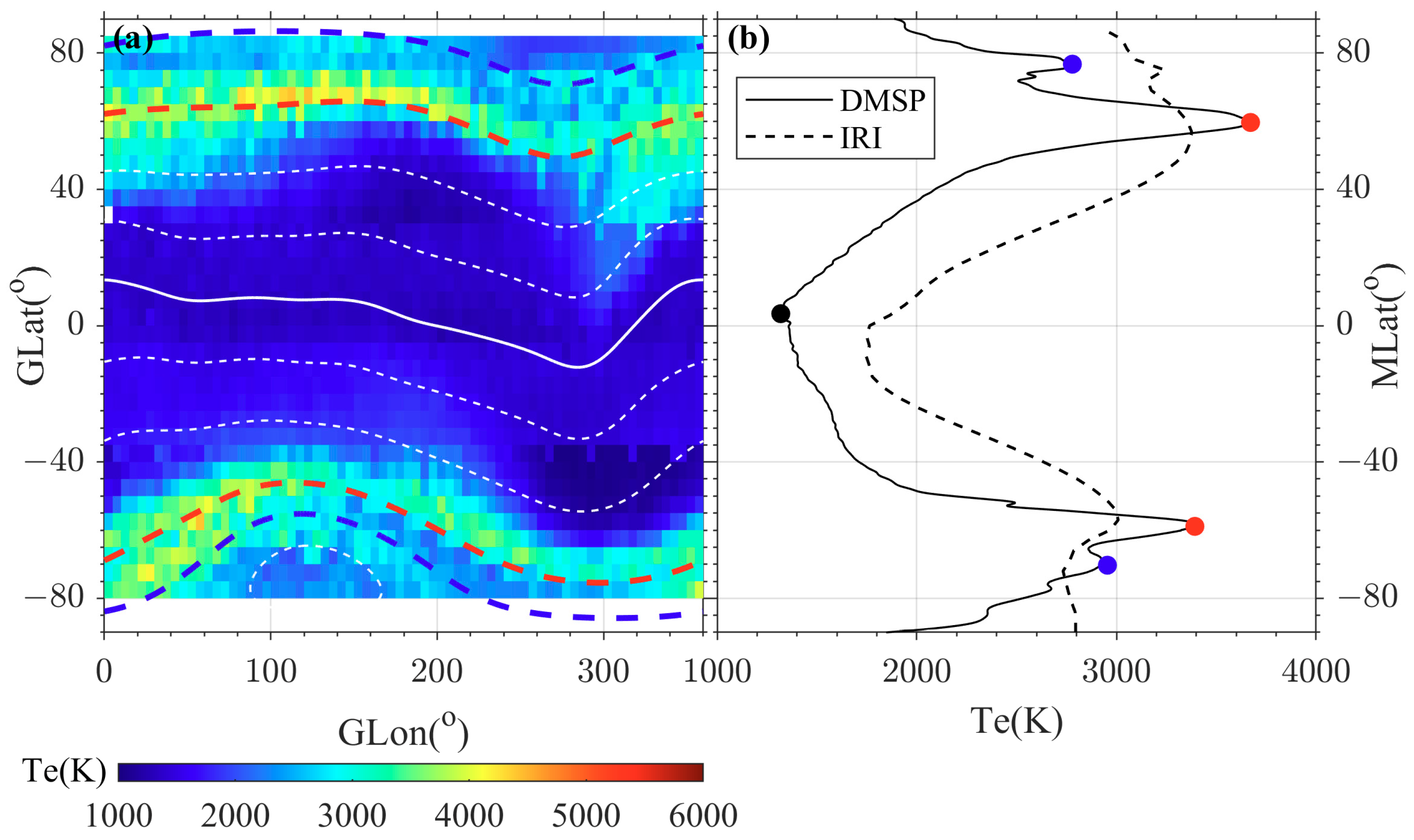

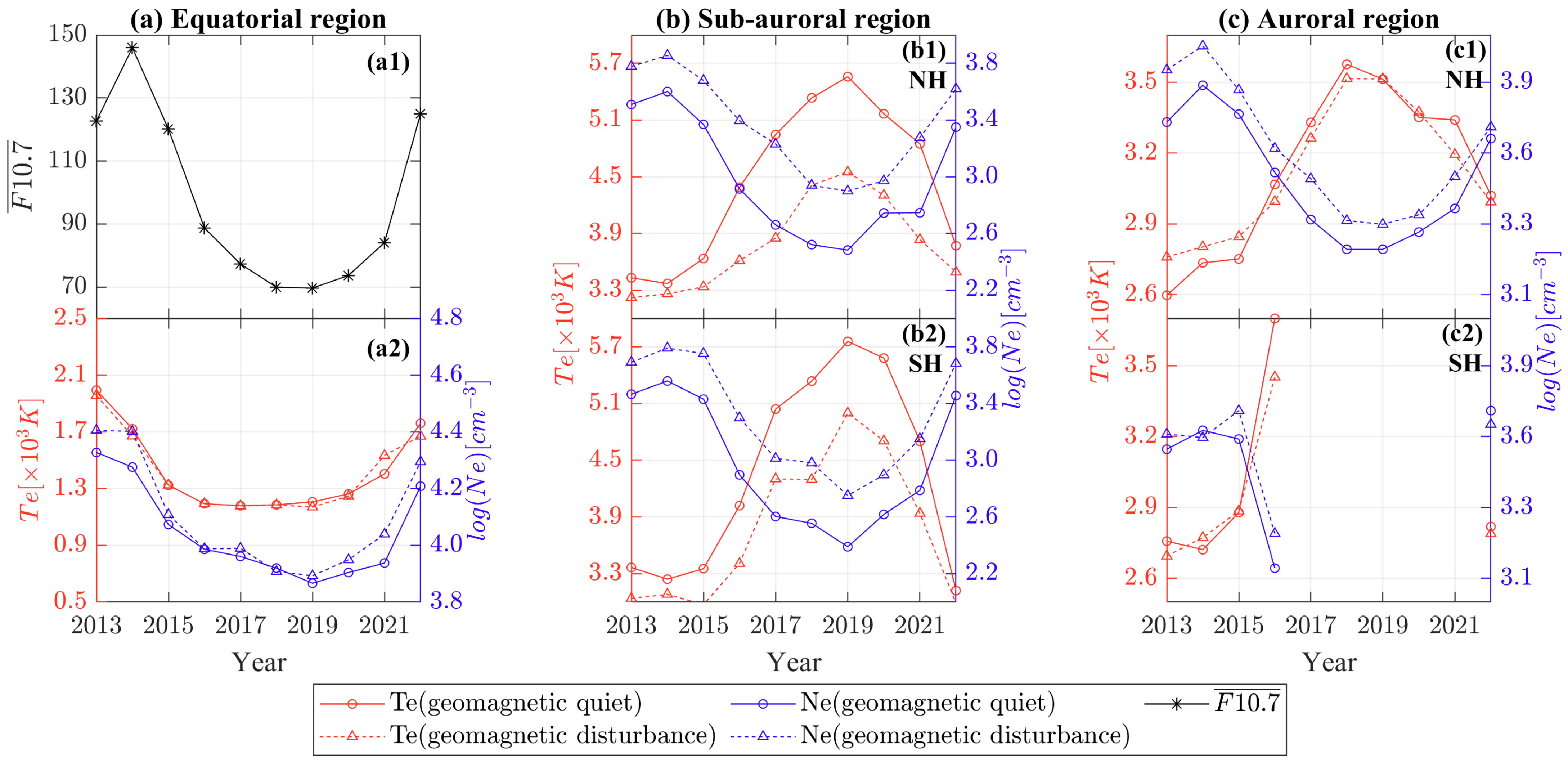
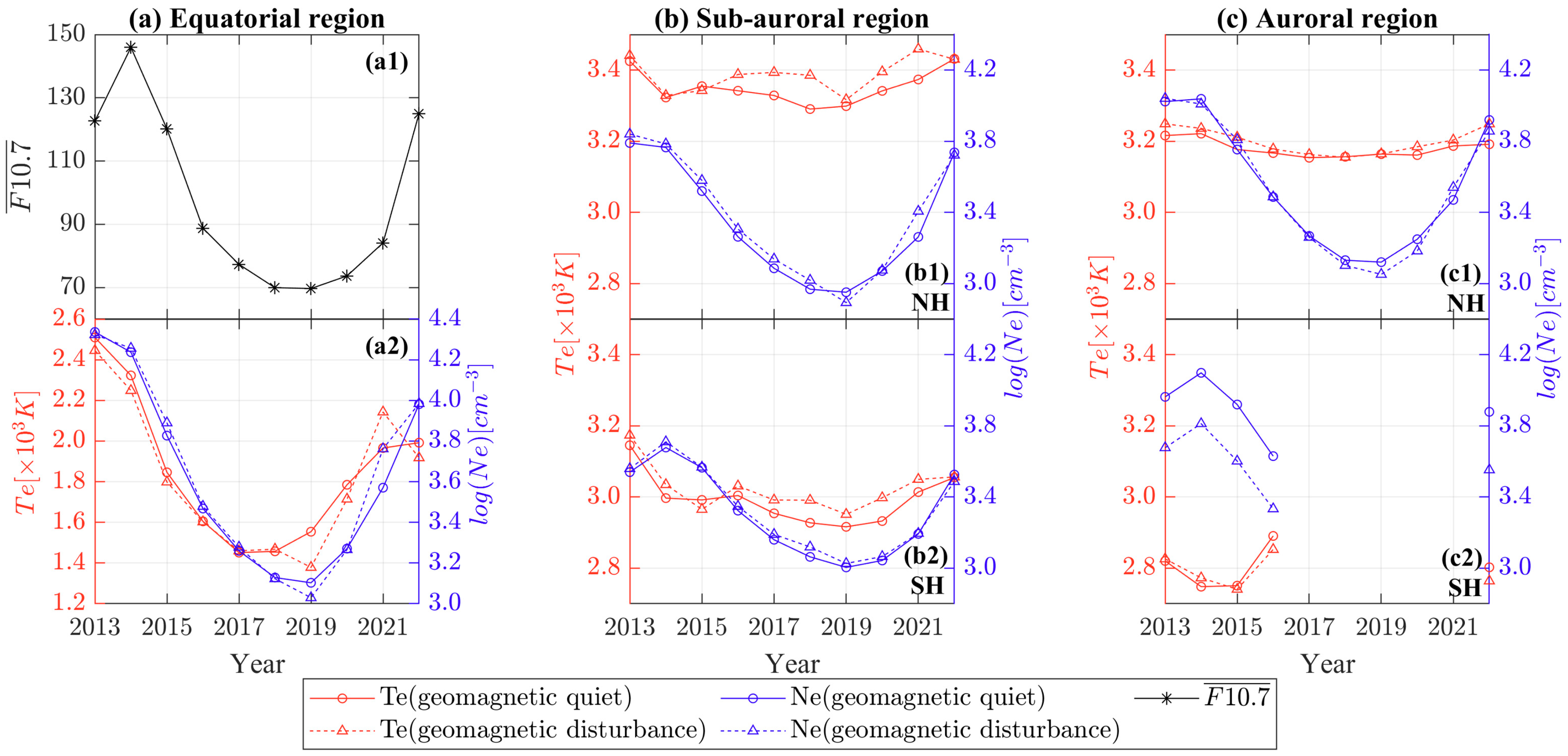
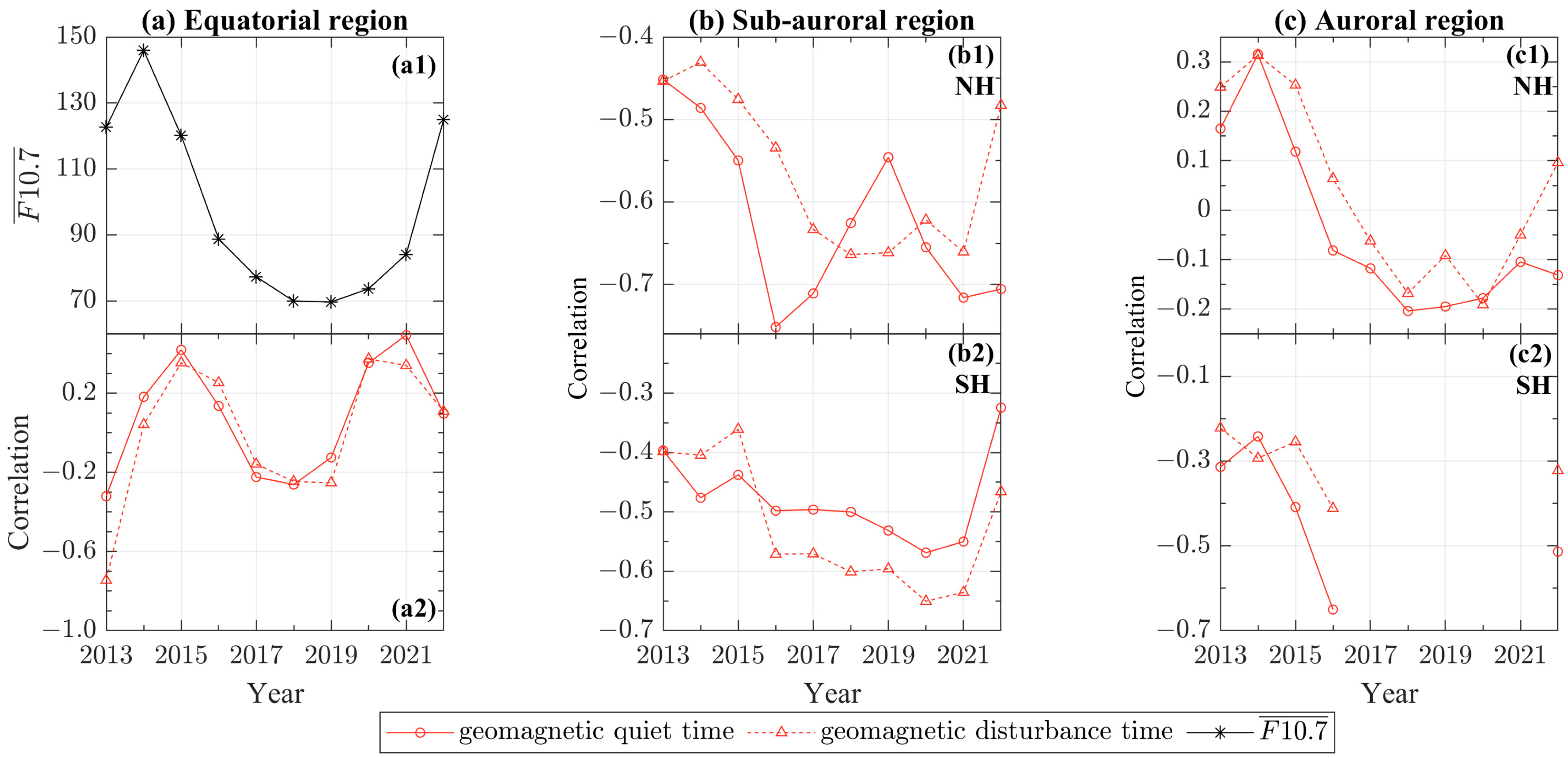
Disclaimer/Publisher’s Note: The statements, opinions and data contained in all publications are solely those of the individual author(s) and contributor(s) and not of MDPI and/or the editor(s). MDPI and/or the editor(s) disclaim responsibility for any injury to people or property resulting from any ideas, methods, instructions or products referred to in the content. |
© 2024 by the authors. Licensee MDPI, Basel, Switzerland. This article is an open access article distributed under the terms and conditions of the Creative Commons Attribution (CC BY) license (https://creativecommons.org/licenses/by/4.0/).
Share and Cite
Liang, J.; Xu, J.; Wu, K.; Luo, J. Latitudinal Characteristics of Nighttime Electron Temperature in the Topside Ionosphere and Its Dependence on Solar and Geomagnetic Activities. Remote Sens. 2024, 16, 2946. https://doi.org/10.3390/rs16162946
Liang J, Xu J, Wu K, Luo J. Latitudinal Characteristics of Nighttime Electron Temperature in the Topside Ionosphere and Its Dependence on Solar and Geomagnetic Activities. Remote Sensing. 2024; 16(16):2946. https://doi.org/10.3390/rs16162946
Chicago/Turabian StyleLiang, Jianyun, Jiyao Xu, Kun Wu, and Ji Luo. 2024. "Latitudinal Characteristics of Nighttime Electron Temperature in the Topside Ionosphere and Its Dependence on Solar and Geomagnetic Activities" Remote Sensing 16, no. 16: 2946. https://doi.org/10.3390/rs16162946
APA StyleLiang, J., Xu, J., Wu, K., & Luo, J. (2024). Latitudinal Characteristics of Nighttime Electron Temperature in the Topside Ionosphere and Its Dependence on Solar and Geomagnetic Activities. Remote Sensing, 16(16), 2946. https://doi.org/10.3390/rs16162946







